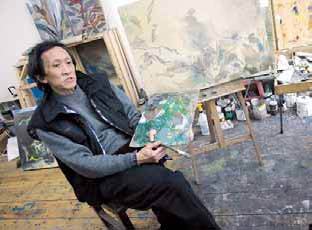Sophie Wang/Shanghai Daily news
Wang Jieyin is a "reclusive artist," but his
studio is unexpectedly sited on Taikang Road, the city's main artistic street.
Scattered with design studios, fashion boutiques, bars and restaurants,
today's Taikang Road is a favorite for fashion hunters.
"The reason is
simple," says the 65-year-old Wang. "This small studio is free, given by the
administrative committee of the art street."
The 40-square-meter studio
is barely decorated and obviously doesn't belong to those luxurious or chic
studios of the "big names."
But Wang, deputy chairman of Shanghai
Artists' Association, has already achieved his fame through his ink-wash
paintings that look like oils. Wang specializes in dim and obscure hues and his
brushstrokes create the impression of the curves and twists of traditional
paintings. The appeal of his paintings lies in the distant and elegant ambience
on his canvases.
Although the artist abandons any recognizable subjects,
viewers will immediately relate his artwork to the ancient rice-paper Chinese
paintings.
"I made this change during my stay in Vienna," Wang says.
Like many of his peers, Wang was once passionate about the striking effects of
oils and the techniques employed to create vividly realistic art. His break came
in 1986 when he went to further his studies at the Academy of Applied Arts in
Vienna.
"I was amazed that some of my Western classmates asked me about
Daoism," he says. "Even I, a Chinese, wasn't able to answer some of their
questions." Since then, he realized the profound and ancient sources could be
nurtured in his paintings. Reading a lot of books about the ancient Chinese
masterpieces, Wang started to absorb them and change in to a new art language.
"I am a very simple person and I don't have much taste for dining or
dressing," he adds. "Yet God is fair. I have a special taste on canvas."
However, sometimes this small studio hinders the man in creating big
works. "I have a way out," he explains joyfully. Wang separates the studio into
two floors to extend the space so that he can check the result of the big canvas
on the first floor while standing on the second floor.
"Sounds like
physical exercise?" he says. "Sure, I desire a big and luxurious studio, but
currently I can't afford one in the downtown area. I prefer my studio to be near
my home."
Although Wang fares well in his paintings, he is reserved in
social activities and has no idea about promoting his art pieces.
"I am
quite lazy," he confesses. "I also feel awkward and uncomfortable at those
social events. After all, the purpose of my painting is for joy not for money."

Wang Jieyin works on a painting at his small
studio on Taikang Road. ¡ª Chen Weiwei
Born in Shanghai
in 1941
Graduated from Shanghai Art School in 1966
Visiting scholar at
the Academy of Applied Art in Vienna in 1986
Professor at the Fine Art
College of Shanghai University since 1987



